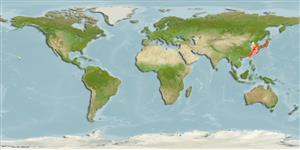Environment: milieu / climate zone / depth range / distribution range
Ekologi
marina bottenlevande; havsvandrande (Ref. 51243); djupintervall ? - 100 m. Subtropical; 46°N - 20°N, 116°E - 153°W
Northwest Pacific: Japan and the eastern Korean Peninsula to the Hawaiian Islands.
Size / Vikt / Age
Maturity: Lm ? range ? - ? cm
Max length : 150 cm TL hane/ej könsbestämd; (Ref. 9988); publicerad maxvikt: 40.0 kg (Ref. 9988)
Short description
Bestämningsnycklar | Morfologi | Morfometri
Taggstrålar i ryggfenan (totalt) : 6 - 7; Mjukstrålar i ryggfenan (totalt) : 29 - 36; Taggstrålar i analfenan: 3; Mjukstrålar i analfenan: 17 - 22; Ryggkotor: 24. Scutes absent. Compared to S. lalandi, the species' dorsoposterior corner of upper jaw is angular (versus rounded) and the pectoral and pelvic fins are almost equal in length (versus pectoral shorter than pelvic fin).
Adults exhibit shoaling habit (Ref. 9988). They feed on plankton. Juveniles are found among floating seaweeds (Ref. 12114, 12115). Collection of young is the basis for prosperous aquaculture in Japan. Raised in captivity and marketed fresh for sashimi (Ref. 9988).
Life cycle and mating behavior
Könsmognad | Reproduktion | Lek | Ägg | Fecundity | Larver
Robins, C.R., R.M. Bailey, C.E. Bond, J.R. Brooker, E.A. Lachner, R.N. Lea and W.B. Scott, 1991. World fishes important to North Americans. Exclusive of species from the continental waters of the United States and Canada. Am. Fish. Soc. Spec. Publ. (21):243 p. (Ref. 4537)
IUCN Red List Status (Ref. 130435: Version 2024-2)
Threat to humans
Harmless
Human uses
Fiskeri: kommersiellt viktig; Vattenbruk: kommersiell; sportfisk: ja
Verktyg
Special reports
Download XML
Internet-källor
Estimates based on models
Phylogenetic diversity index (Ref.
82804): PD
50 = 0.5020 [Uniqueness, from 0.5 = low to 2.0 = high].
Bayesian length-weight: a=0.01122 (0.00514 - 0.02450), b=3.04 (2.87 - 3.21), in cm total length, based on all LWR estimates for this body shape (Ref.
93245).
Trofisk nivå (Ref.
69278): 4.0 ±0.65 se; based on food items.
Generation time: 3.4 ( na - na) years. Estimated as median ln(3)/K based on 1
growth studies.
Resiliens (Ref.
120179): Mellan, lägsta populationsfördubblingstid 1,4-4,4 år (K=0.3-0.5).
Prior r = 0.57, 95% CL = 0.38 - 0.85, Based on 1 data-limited stock assessment.
Fishing Vulnerability (Ref.
59153): Moderate to high vulnerability (52 of 100).
Climate Vulnerability (Ref.
125649): Very high vulnerability (100 of 100).
Nutrients (Ref.
124155): Calcium = 52.4 [32.1, 127.7] mg/100g; Iron = 1.36 [0.76, 2.65] mg/100g; Protein = 18.9 [16.0, 21.8] %; Omega3 = 0.334 [0.213, 0.557] g/100g; Selenium = 37.3 [19.1, 79.6] μg/100g; VitaminA = 17.4 [2.2, 126.7] μg/100g; Zinc = 0.428 [0.301, 0.639] mg/100g (wet weight);
